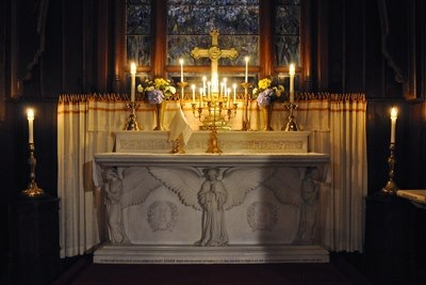WORSHIP
Worship the Lord with gladness; come before him with joyful songs. Know that the Lord is God. It is he who made us, and we are his; we are his people, the sheep of his pasture. -Psalm 100:2,3

The word worship comes from an old English word that means "to give worth to something." Humans were made to praise and give worth to things outside ourselves, and we do this naturally: sometimes in healthy ways (when we worship God), and sometimes in not-so-healthy ways (if we obsess about celebrities, looking or acting perfect, money, etc.).
Worship isn't just something we do on Sundays; as individuals, our whole lives should be an act of worship to the living God who made us and loves us. As a community, Sunday is the day we come together to worship God more formally (and Saturday evening, for some). We do this by singing together, reading from the Bible out loud, praying together, listening to a sermon (a teaching from the pastor), and partaking of Holy Communion (also called the Eucharist).
This order of service is called a liturgy. The word liturgy simply translates as the "work of the people." All churches -- whether Catholic, Lutheran, Baptist, Presbyterian, Episcopalian or non-denominational -- have some sort of a liturgical pattern that is routine for worship. At St. Paul's, the liturgy is from the Book of Common Prayer (BCP), which is used in Episcopal Churches throughout the United States. The BCP has had several editions dating back to the time of the reformation (the first being in 1549), and thus, Anglican churches throughout the world have services that are similar to the BCP in the United States.
Aside from the distinct pattern of worship on Sunday, there are also patterns throughout the year. These patterns are called the liturgical seasons of the church. "Just as there are cycles within nature, the early church found it good to remember the various themes of the gospel through seasons. That is why at Lent we focus on penitence, sin and mortality remembering Christ’s temptation, persecution and death. During Easter, we feast knowing Christ has risen, promises to make all things new and return again. What it looks like: You will see the seasons visually expressed through the changing colors [on our robes], the draperies on the table and pulpit. This is a subtle reminder that we are ever proceeding through the seasons and we can be participators in their themes; knowing it is good to remember all of the Great Story present in the scriptures."
(Portion in quotes adapted from Trinity Anglican Mission, About Us)
Worship isn't just something we do on Sundays; as individuals, our whole lives should be an act of worship to the living God who made us and loves us. As a community, Sunday is the day we come together to worship God more formally (and Saturday evening, for some). We do this by singing together, reading from the Bible out loud, praying together, listening to a sermon (a teaching from the pastor), and partaking of Holy Communion (also called the Eucharist).
This order of service is called a liturgy. The word liturgy simply translates as the "work of the people." All churches -- whether Catholic, Lutheran, Baptist, Presbyterian, Episcopalian or non-denominational -- have some sort of a liturgical pattern that is routine for worship. At St. Paul's, the liturgy is from the Book of Common Prayer (BCP), which is used in Episcopal Churches throughout the United States. The BCP has had several editions dating back to the time of the reformation (the first being in 1549), and thus, Anglican churches throughout the world have services that are similar to the BCP in the United States.
Aside from the distinct pattern of worship on Sunday, there are also patterns throughout the year. These patterns are called the liturgical seasons of the church. "Just as there are cycles within nature, the early church found it good to remember the various themes of the gospel through seasons. That is why at Lent we focus on penitence, sin and mortality remembering Christ’s temptation, persecution and death. During Easter, we feast knowing Christ has risen, promises to make all things new and return again. What it looks like: You will see the seasons visually expressed through the changing colors [on our robes], the draperies on the table and pulpit. This is a subtle reminder that we are ever proceeding through the seasons and we can be participators in their themes; knowing it is good to remember all of the Great Story present in the scriptures."
(Portion in quotes adapted from Trinity Anglican Mission, About Us)